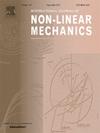基于参数灵敏度分析的磁流变阻尼器高保真优化模型的建立
IF 3.2
3区 工程技术
Q2 MECHANICS
International Journal of Non-Linear Mechanics
Pub Date : 2025-05-06
DOI:10.1016/j.ijnonlinmec.2025.105128
引用次数: 0
摘要
磁流变阻尼器是一种流行的半主动控制装置,本文建立了一种高保真的优化数学模型,克服了现有参数化模型辨识和仿真过程复杂的普遍缺点。利用龙卷风图和蒙特卡罗模拟进行了严格的敏感性分析,以减少具有21个振幅和电流参数的修正Bouc-Wen模型的参数数量。在灵敏度分析之前,对实验室规模的磁流变阻尼器进行了详细的实验研究,通过一系列位移控制试验获得了其非线性滞回特性。灵敏度分析和穷举搜索结果表明,最优的Bouc-Wen模型较好地反映了阻尼器的非线性力-位移和力-速度特性。利用遗传算法进行参数辨识的结果表明,最优模型的精度与原改进的Bouc-Wen模型相同,且在辨识出的最优模型情况下,1000次迭代的平均仿真时间显著缩短,最高可达56%。最后,对一个多自由度基础隔震建筑进行了数值研究,以评估优化模型准确模拟MR阻尼器非线性特性的能力。此外,分析结果加强了数学模型在结构系统半主动振动控制中的广泛应用。本文章由计算机程序翻译,如有差异,请以英文原文为准。
Development of a high-fidelity and optimal model for magneto-rheological damper by parametric sensitivity analysis
This paper develops a high-fidelity and optimal mathematical model for the magneto-rheological (MR) damper, a popular semiactive control device, that can overcome the generic shortcomings of the existing parametric models, such as complex identification and simulation processes. A rigorous sensitivity analysis was performed using tornado diagrams and Monte Carlo simulations to reduce the number of parameters in the modified Bouc–Wen model with 21 amplitude and current parameters. Before the sensitivity analysis, a detailed experimental study with a laboratory-scale MR damper was performed to obtain its nonlinear hysteretic behavior through a series of displacement-controlled tests. From the results of the sensitivity analyses and exhaustive search, it was observed that the optimal Bouc–Wen model perfectly captured the nonlinear force–displacement and force–velocity behaviors of the damper. Moreover, the parameter identification results obtained using a genetic algorithm confirmed that the accuracy of the optimal model was the same as that of the original modified Bouc–Wen model, and the average simulation time of 1000 iterations was reduced considerably by up to 56% in the identified optimal model case. Finally, a numerical study was conducted on a multi-degree-of-freedom base-isolated building to evaluate the ability of the optimal model to simulate accurately the experimentally obtained nonlinear behavior of an MR damper. Additionally, the analysis results reinforce the broader use of mathematical models in the semiactive vibration control of structural systems.
求助全文
通过发布文献求助,成功后即可免费获取论文全文。
去求助
来源期刊
CiteScore
5.50
自引率
9.40%
发文量
192
审稿时长
67 days
期刊介绍:
The International Journal of Non-Linear Mechanics provides a specific medium for dissemination of high-quality research results in the various areas of theoretical, applied, and experimental mechanics of solids, fluids, structures, and systems where the phenomena are inherently non-linear.
The journal brings together original results in non-linear problems in elasticity, plasticity, dynamics, vibrations, wave-propagation, rheology, fluid-structure interaction systems, stability, biomechanics, micro- and nano-structures, materials, metamaterials, and in other diverse areas.
Papers may be analytical, computational or experimental in nature. Treatments of non-linear differential equations wherein solutions and properties of solutions are emphasized but physical aspects are not adequately relevant, will not be considered for possible publication. Both deterministic and stochastic approaches are fostered. Contributions pertaining to both established and emerging fields are encouraged.

 求助内容:
求助内容: 应助结果提醒方式:
应助结果提醒方式:


